
Dissanthelium californicum is a rare species of grass. It was originally discovered on Santa Catalina, an island off California's coast in 1847 by U.S. botanist and naturalist William Gambel. It was later identified as growing on Guadalupe Island, on San Clemente Island and Catalina Island.

Fremontodendron californicum, with the common names California flannelbush, California fremontia, and flannel bush, is a flowering shrub native to diverse habitats in southwestern North America.

Dissanthelium is a genus of plants in the grass family. It is native to the Americas, especially in the Andes of South America.
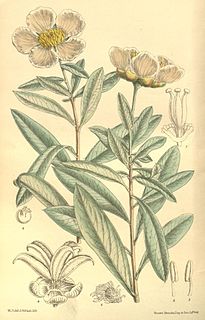
Crossosomataceae is a small plant family, consisting of four genera of shrubs found only in the dry parts of the American southwest and Mexico. This family has included up to ten species in the past, although as of 2021 six species are still recognised. Crossosoma are shrub-like plants which can vary from being 50 cm to 5 meters tall, with small alternating leaves that surround the stem, or leaves clustered in small spurts (fascicles). Apacheria, however, has opposite leaves. Crossosoma has usually white flowers that are generally bisexual and have 5 petals attached to a nectary disk, but in Velascoa the flowers are campanulate and have an extremely reduced nectary disk.

Microseris is a genus of plants in the tribe Cichorieae within the family Asteraceae, native to North America, Australia, and New Zealand. It contains the following species:

Eriodictyon angustifolium, common name narrowleaf yerba santa, is a perennial shrub.

Eriodictyon crassifolium, or thickleaf yerba santa, is a shrub in the borage family. "Crassifolium" means "thick leaf." The plant has thick, wooly leaves. It is native to California and Baja California.

Papaver californicum is a species of poppy known by the common names fire poppy and western poppy.
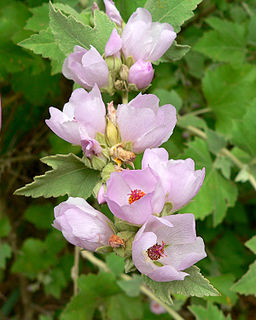
Malacothamnus (bushmallow) is a genus of shrubs and subshrubs found throughout much of mainland California and on three of the Channel Islands. Outside of California, Malacothamnus is known from the northern half of Baja California, from a disjunct location in central Arizona, and possibly from a historic location that may have been in southern Arizona or adjacent Mexico. Plants of this genus are most commonly found in early-successional, post-burn plant communities. Malacothamnus are currently thought to be most closely related to the Iliamnas of the US interior and the Phymosias of Mexico, Central America, and the Caribbean.

Lycium californicum is a spreading shrub in the nightshade family known by the common names California boxthorn and California desert-thorn.

Tropidocarpum is a genus of flowering plants in the family Brassicaceae. There are two to four species, one of which is extremely rare. Tropidocarpum capparideum, the caper-fruited tropidocarpum, is a plant endemic to California generally considered to be extinct since the 1950s, but has been reported since. Specimens were collected at Fort Hunter Liggett, California, in 2000 and 2001. Its status is currently in debate. The other member of the genus, the dobie pod, T. gracile, is a common mustardlike plant in California and Baja California. It is proposed that two other plants in separate monotypic genera, Twisselmannia and Agallis, be moved to Tropidocarpum.
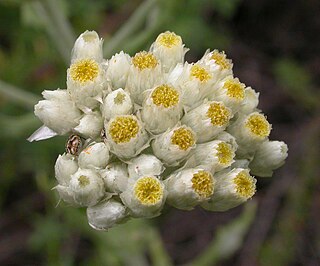
Pseudognaphalium californicum is a species of flowering plant in the family Asteraceae known by several common names, including ladies' tobacco, California rabbit tobacco, California cudweed, and California everlasting.

Blitum californicum is a species of flowering plant in the amaranth family known by the common names California goosefoot and (ambiguously) "Indian lettuce".
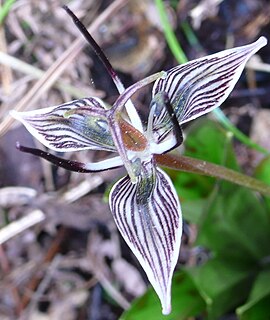
Scoliopus, or fetid adderstongue, is a genus of plant within the family Liliaceae consisting of two species, Scoliopus bigelovii and S. hallii. Both are found in deep shaded forests, primarily in the coastal counties of the western United States from central California to northern Oregon. The name "Scoliopus" derives from the Greek words skolios and pous, meaning curved foot, a reference to the shape of the pedicel. Taxonomists believe that Scoliopus is closely related to Calochortus, Prosartes, Streptopus and Tricyrtis, which all have creeping rhizomes as well as styles that divide at the tip.

Crossosoma bigelovii, known by the common name ragged rockflower, is one of only a few species in the flowering plant family Crossosomataceae.

Crossosoma californicum, known by the common name California rockflower, is one of only a few species in the flowering plant family Crossosomataceae.
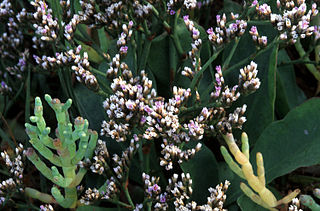
Limonium californicum is a species of sea lavender in the family Plumbaginaceae. It is known by the common names western marsh rosemary and California sea lavender.

Ophioglossum californicum, known by the common name California adder's tongue, is an uncommon species of fern in the family Ophioglossaceae.
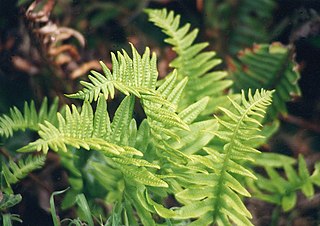
Polypodium californicum is a species of fern known by the common name California polypody.

Selaginella bigelovii is a species of spikemoss known by the common names bushy spikemoss and Bigelow's spikemoss. It is native to California and Baja California, where it grows in rocky places in many different habitat types, from the coastline to the mountains to the deserts. This lycophyte forms clumps of spreading upright to erect stems up to 20 centimeters long with a few short lateral branches. The linear or lance-shaped green leaves are up to 4 millimeters long, including the tiny rigid bristles at their tips. They are flattened to the stem or stick out just a little. The strobili borne at the leaf bases are yellow-orange in color.



















